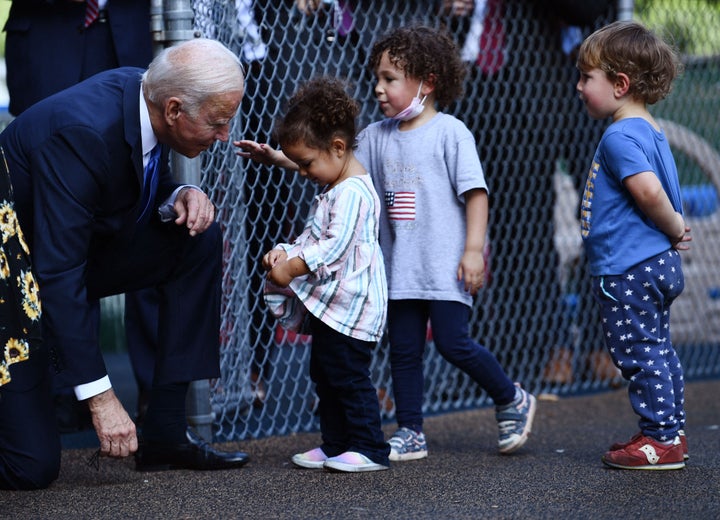If you are in a working family and have managed to hold on to your child care during the past two years, you may have the federal government to thank, according to a new report.
Child care providers have faced severe financial pressures during the coronavirus pandemic because of lockdowns and absences that reduced their revenue, as well as the need to invest in expensive new safety measures and, most recently, the high cost of retaining or hiring workers in a super-tight labor market.
Literally tens of thousands of child care providers have downsized or shut down, leaving families scrambling to find alternatives ― whether it’s relying on more informal care or just keeping kids at home. It’s one reason so many working parents, especially women, have reduced their hours or dropped out of the U.S. workforce entirely.
But the wave of downsizing and closures in the child care industry would have been way more severe if not for the federal government spending many billions of dollars to prop up child care, the new report says.
An Assessment Of The Recent Past, Roughly
The report comes from The Century Foundation, a nonpartisan liberal think tank. By design, the report appeared on Thursday morning, a day before the one-year anniversary of the American Rescue Plan.
ARP, passed by Democrats on a party-line vote and signed into law by President Joe Biden, was the last and biggest of the major COVID-19 relief acts. It included roughly $40 billion in new spending to support child care providers, who could spend the money on worker compensation, physical improvements and paying off debt from the pandemic, among other uses.
About 75,000 providers avoided closure because of the money, the report says, preserving more than 3 million slots. That would work out to about one-third of the nation’s total supply of child care slots, according to co-author Rasheed Malik, who is director of early childhood policy at the liberal Center for American Progress.

The report’s calculations draw on data from two independent groups that focus on early childhood: the National Association for the Education of Young Children and Child Care Aware. The report also relies on a separate analysis the Center for American Progress did several years ago.
None of these estimates are anywhere close to definitive, making any extrapolation from them necessarily rough, as Malik and report co-author Julie Kashen readily acknowledged in an interview with HuffPost.
But chronically poor tracking of child care in the U.S. makes it difficult to find more precise numbers, the co-authors said, and the estimates in the report are solid enough to capture the overall impact of federal relief policies.
“When Congress puts money into the child care sector, it makes a difference.”
- Julie Kashen, The Century Foundation
“The bottom line is that a significant amount of the childcare sector was stabilized by the COVID relief funding,” said Kashen, who is a senior fellow at The Century Foundation and director of its economic justice program.
Anecdotal evidence backs up that judgment, whether it’s child care facility operators telling reporters how funds saved their establishments or elected officials telling constituents how they’ve put federal money to use.
The money didn’t get to everybody who needed it, and sometimes, it took a while to make its way past familiar bureaucratic obstacles.
But few officials dispute that it’s made a difference, with even partisan Republican governors like Iowa’s Kim Reynolds touting the benefits of the federal rescue money that came from Democrats in Washington.
A Lesson For The Future, Maybe
The report’s nominal focus is the impact of federal relief money designed to help child care providers get through the pandemic. But implicitly, it’s also making the case for a larger, more long-term investment.
Child care was already in something of a crisis even before COVID-19. Providers had a hard time finding enough qualified workers because the pay was so low, but they couldn’t raise salaries without charging more ― something that was nearly impossible with so many families struggling to afford existing fees and government assistance so limited.
The result was a lot of stressed-out families and a lot of low-quality care.
Biden and Democratic leaders came into office promising to address these long-term problems and eventually made an even bigger child care initiative part of the “Build Back Better” legislation they put together last year.
They are still hoping to pass some form of that legislation through a compromise with Joe Manchin, the Democratic senator from West Virginia whose objections have effectively killed Build Back Better in its current form. Manchin has, in the past, signaled his support for parts of the Democratic early childhood agenda, giving advocates hope that it could be part of any final deal that emerges from negotiations.
But the Democratic child care proposal has run into plenty of criticism from other sources across the political spectrum, with some analysts and advocates arguing that the proposal is too big and would impose too much regulation, and others arguing that it’s too small and wouldn’t do enough to guarantee access.
The Century Foundation’s report doesn’t address those concerns. But its authors, both of whom advised lawmakers putting together the Build Back Better proposal, think the record of federal child care spending during the pandemic ought to build confidence that a longer-term initiative will help.
“What we see here is that when Congress puts money into the child care sector, it makes a difference,” Kashen said. “But that was temporary money and, at the end of it, we’re only going to be closer to where we were before, which wasn’t very good. And so it reinforces the need for more comprehensive investments into building the system.”
CORRECTION: The federal government has spent billions supporting child care during the pandemic, not trillions as reported in an earlier version.

